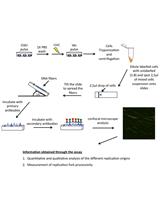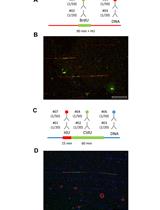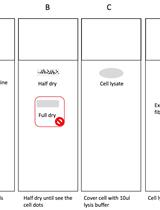- EN - English
- CN - 中文
Evaluation of Genotoxicity by Micronucleus Assay in vitro and by Allium cepa Test in vivo
利用微核体外分析系统和洋葱体内实验进行遗传毒性测试
发布: 2019年07月20日第9卷第14期 DOI: 10.21769/BioProtoc.3311 浏览次数: 8585
评审: Alexandros AlexandratosXinyan ZhangCristina Isabel Carvalho
Abstract
The in vitro and in vivo genotoxicity of new metallodrugs either as Small Bioactive Molecules (SBAMs) or Conjugates of Metals with Drugs (CoMeDs) is evaluated by the micronucleus test and the Allium cepa assay, respectively. Fetal lung fibroblast cells (MRC-5), normal human corneal epithelial cells (HCEC) and immortalized human keratinocytes cells (HaCaT) were incubated with solutions of SBAMs or CoMeDs at their IC50 values for 48 h (the concentration of a compound which is required to inhibit the cells growth by 50% in relation to the non-treated cells). The micronucleus abundance percentage towards the corresponding one, of the non-treated cells indicates the in vitro genotoxicity of the formulations. The in vivo Allium cepa test comprises the exposing of the plant Allium cepa roots to an SBAMs or a CoMeDs solution for 48 h. The percentages of the mitotic index, the chromosome aberrations, the nuclear abnormalities and the presence of the micronucleus are calculated indicating the in vivo genotoxicity of the agent.
Keywords: Biological inorganic chemistry (生物无机化学)Background
Inorganic biochemistry, biological inorganic chemistry or bioinorganic chemistry is a multidiscipline scientific field which combines biological inorganic chemistry, biochemistry, biology, medicinal chemistry, microbiology and other fields (Latsis et al., 2018). Nowadays, the research on the design and development of new metallodrugs [Small Bioactive Molecules (SBAMs) or Conjugates of Metals with Drugs (CoMeDs)] against numerous cancer types, includes their biological activity towards cancerous and non cancerous models (Banti et al., 2016; Sainis et al., 2016; Banti et al., 2018; Chrysouli et al., 2018a and 2018b; Latsis et al., 2018; Milionis et al., 2018; Stathopoulou et al., 2018; Banti et al., 2019; Polychronis et al., 2019). Especially, the development of new SBAMs or CoMeDs imposes the need to assess their potential in vitro and in vivo toxicity against experimental models in order to check their potential risks (Banti et al., 2016; Sainis et al., 2016; Banti et al., 2018; Chrysouli et al., 2018a and 2018b; Latsis et al., 2018; Milionis et al., 2018; Stathopoulou et al., 2018; Banti et al., 2019; Polychronis et al., 2019). Therefore, the micronucleus assay has been developed in monitoring genetic damage in normal human cells as it is a sensitive tool for toxicity screening and it is capable in reducing the use of animals in toxicological testing (Sahu et al., 2014). The presence of micronucleus (MN) is a biomarker of mutagenic, genotoxic, or teratogenic agent influence (Torres-Bugarín et al., 2014). The in vitro genotoxicity is calculated by checking the micronucleus frequency, upon treatment of normal cells by an agent at the concentration of its IC50 value (Chrysouli et al., 2018a and 2018b; Latsis et al., 2018; Milionis et al., 2018; Sainis et al., 2016; Stathopoulou et al., 2018). The
Materials and Reagents
- Micronucleus assay
- Latex gloves (KCWW, Kimberly-Clark, catalog number: 57330)
- Pipette tips (Sterile)
- 100 mm Petri dishes (SARSTEDT, catalog number: 83.3902), mammalian cell culture containers for adherent cells
Note: Any other Petri dishes or flask suitable for your cell line may work. - Microscope slides (UltiDent Scientific, catalog number: 170-7107A)
Note: Any microscope slide that fits on your microscope can be used. - Cover glass (UltiDent Scientific, catalog number: 170-C1818)
Note: Any cover glass can be used. The best cover glasses are the #1.5; however #1.0 or #0 may be used if high quality images are not required. - 6-well tissue culture treated plate (Corning, catalog number: 3506)
- 24-well tissue culture plate (Corning, catalog number: 3524)
- Mammalian non cancerous adherent cells, for example, MRC-5, HCEC, HaCaT cells, etc.
- Required complete culture media
- DMEM (WISENT, catalog number: 319-005-EL)
Note: The growth medium is adapted for each cell line. Verify with the cell line suppliers to determine the optimal growth medium for the cells and the necessary supplements. - Fetal bovine serum (FBS) (WISENT, catalog number: 095150)
Note: Usually, a 10% v/v solution is used, but some cell lines will require different concentrations. See with your cell line supplier. - Penicillin/streptomycin (WISENT, catalog number: 450-201-EL)
Note: It is usually supplied as a 100x stock and therefore must be diluted 1:100 in DMEM. - L-glutamine (Sigma-Aldrich, catalog number: G3126)
- DMEM (WISENT, catalog number: 319-005-EL)
- Trypsin (0.05% or 0.25% in PBS) (Thermo Fisher Scientific, GibcoTM, catalog number: 25200072)
- Phosphate buffer saline (PBS, 1x) (Sigma-Aldrich, catalog number: P-4417)
- Potassium chloride (KCl) (Sigma-Aldrich, catalog number: P9541)
- Acetic acid (Sigma-Aldrich, catalog number: 320099)
- Methanol (Sigma-Aldrich, catalog number: 34860)
- Acridine orange (Sigma-Aldrich, catalog number: A8097)
- 70% ethanol
- Metallodrugs (at IC50 values)
- FBS
- Allium cepa assay
- Onions bulbs (Allium cepa), approximately 1.5-2.0 cm in diameter
- Razor blades
- Pipette tips
- Glass microscope slide (75 x 25 mm) (VWR, catalog number: 48300-025)
- Coverslips (Fisher Scientific, catalog number: 12-543D)
- Eppendorf tubes 1.5 ml (VWR, catalog number: 89000-028)
- Test tubes (10 ml) (BOROSIL, catalog number: 9820U04)
- Pencil with an eraser
- Nail polish (nitrocellulose dissolved in butyl and ethyl acetate)
- Double distilled water (ddH2O), standard for highly purified laboratory water for biochemical experiments.
- Hydrochloric acid (e.g., Merck, catalog number: HX0603-75)
- Acetic acid (e.g., Merck, catalog number: AX0073-6)
- Schiff’s reagents (HiMedia Laboratories, catalog number: S074-500ML)
- Nail polish
Equipment
- Micronucleus assay
- Laminar flow hood
- Hemocytometer
- Pipettes (any pipettes will do)
- Incubator (any incubator is fine if it maintains 5% CO2 and moisture)
- Fluorescent microscope (Nikon Instruments, model: Eclipse E800) with highly sensitive camera (ANDOR, model: Zyla 5.5) controlled by Nikon NIS-Elements software
- Allium cepa assay
- Incubator
Note: Any incubator is fine if it maintains 25 °C and 37 °C, 50-60% humidity and 12 h day lighting/ 12 h dark for 48 h. - Light microscope (Olympus, 10x objective)
- Digital camera (Nikon, model: COOLPIX P100, 10.3 megapixel, 26x zoom)
- Incubator
Software
- For both Micronucleus assay and Allium cepa assays: Microsoft Office Excel
Procedure
文章信息
版权信息
© 2019 The Authors; exclusive licensee Bio-protocol LLC.
如何引用
Banti, C. N. and Hadjikakou, S. K. (2019). Evaluation of Genotoxicity by Micronucleus Assay in vitro and by Allium cepa Test in vivo. Bio-protocol 9(14): e3311. DOI: 10.21769/BioProtoc.3311.
分类
癌症生物学 > 癌症生物化学 > 基因毒性
生物化学 > DNA > 单分子活性
细胞生物学 > 细胞染色 > 核酸
您对这篇实验方法有问题吗?
在此处发布您的问题,我们将邀请本文作者来回答。同时,我们会将您的问题发布到Bio-protocol Exchange,以便寻求社区成员的帮助。
提问指南
+ 问题描述
写下详细的问题描述,包括所有有助于他人回答您问题的信息(例如实验过程、条件和相关图像等)。
Share
Bluesky
X
Copy link














